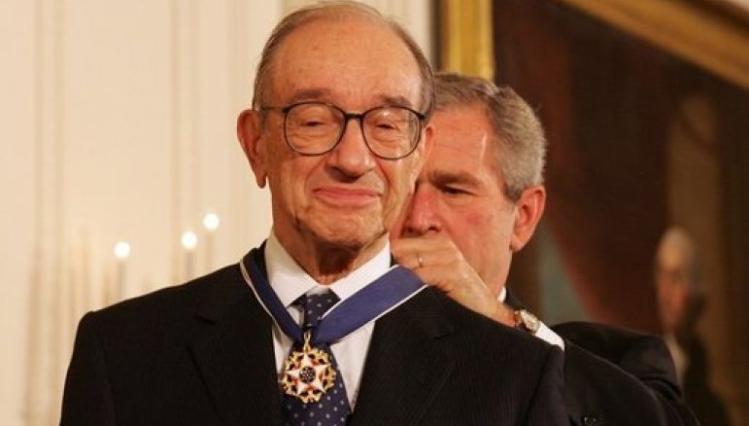
It has long been a truism among economists that free trade—competing on price and quality without tariffs or subsidies—is the ideal. Free-trade doctrine is not squeamish about job losses, and abhors protections for favored industries. The more nations concentrate on what they do best, the greater the national wealth on both sides of the trade. Some workers and companies will surely be displaced by overseas competitors, but the cost savings will generate enough economic activity to absorb the displacement.
Free trade became an American mantra after WWII, a time when the United States had almost all the world’s money, and was doubly blessed with the wisest leadership cadre since the founders. Statesmen like George Marshall, Dean Acheson, George Kennan, and Chip Bohlen understood the importance of rebuilding Europe and Japan, and the necessity of redistributing the world’s wealth. Marshall Plan loans were a start, but turning the former belligerents into exporters, particularly to the United States, was of crucial importance.
American reconstruction policies were a great success and ushered in a golden age of prosperity and freedom. But Americans lolled rather too long in their catbird seat and, in the late 1960s and the 1970s, found themselves deluged with high-quality, low-priced products from overseas, especially automobiles and consumer electronics. Howls for protection rose on all sides, but a couple of decades of economic research demonstrated that the benefits of free trade still prevailed. Yes, jobs were displaced, but workers were by and large still being absorbed by expanding American companies, to the benefit of both trading partners.
A breakpoint in that happy story came when China was admitted to the World Trade Organization (WTO) in 2001, with strong American backing. China had long been trading with America, and indeed had “Most Favored Nation” (MFN) status, the hallmark of an established and trustworthy trading partner. But the WTO rules were stricter in ways that helped China. They forced more trade away from the state-owned manufacturing dinosaurs, and they gave China access to more imported components for high-tech products. The WTO also helped stabilize Chinese planning, because the American government had insisted on granting MFN status for only a year at a time.
Almost immediately, the Chinese unleashed a manufacturing blitzkrieg on the rest of the world. From 2000 to 2014, the Chinese share of the world’s value-added manufacturing tripled, from about 8 percent to just under 25 percent. And it wasn’t just in the United States; Japan, Germany, Australia, and New Zealand saw about the same level of growth in Chinese imports. Along the way, the Chinese created a dismal trail of “dumping” goods below cost to take market share from local competitors. America’s Nucor Steel is one of the most efficient steel producers in the world. Its labor cost to make a ton of steel sheet is only about $8-10, it has extremely low raw-material and energy costs, and it’s located here. China has to import its raw materials, uses expensive energy inefficiently, and must ship the finished product to America. Even at zero labor costs, China could not undersell the best American companies. But somehow it has still cut heavily into the domestic sales of Nucor and all other American companies, and it gets away with this. Or did: as this column is going to press, the United States has just imposed a crippling tariff on most Chinese steel.
The Chinese drive on world manufacturing has devastated American jobs. A recent paper by academic experts calculates that the Chinese trade invasion caused a 2.4 million reduction in American jobs, with most of the losses in the less skilled 40 percent of job categories. In contrast to previous eras, moreover, the displaced workers are not relocating, suggesting that the American work force has lost some of its legendary mobility. The loss of incomes is bad enough, but the same paper calculates that every $1,000 per-worker increase in imports from China imposes a public cost of $103 in annual food stamps, unemployment benefits, and other transfer payments to each displaced worker.
Fecklessly, the George W. Bush administration and Alan Greenspan’s Federal Reserve facilitated the Chinese invasion. American household incomes sagged badly in the 2000s, but very cheap credit, casually dispensed and secured mostly by home mortgages, allowed Americans to maintain their accustomed spending. The consumer spree pumped up the trade deficit by $5.1 trillion in 2000-2008, a very large share of which went to China, which now reigns as America’s largest creditor. And the inevitable wave of defaults by underwater borrowers and banks created the Great Recession.
The Chinese run may now be hitting a wall. Labor costs have been rising sharply, to the point where all-in costs, including shipping, are no longer much of a barrier to a determined American competitor. Years of snapping up mineral wealth from Africa, Latin America, and the former Soviet states have made a big dent in the Chinese government’s dollar mountain, and the collapse in commodity prices will burn through even more savings. President Xi Jinping’s heavy-handed crackdown on dissent and his insistence on lip service to Communist orthodoxy have a worrisome Maoist tinge. It is still not clear whether Xi’s drive against corruption is real or just a way of silencing his political opposition. Nor is it clear where a billion Chinese will find breathable air and potable water.
The Chinese blitz on the rest of the world may be a one-time event. But there are surely lessons to be learned, and it’s time we leaven our free-trade pieties with some of the harsher lessons of the past fifteen years.
Please email comments to [email protected] and join the conversation on our Facebook page.
Share
Previous Story
An Heir to the Sanders 'Revolution'?
Next Story
Why Bernie Sanders Won Last Night's Democratic Debate